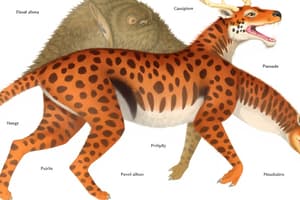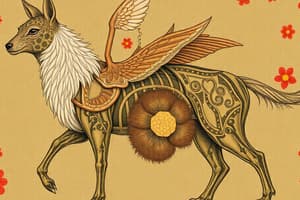Podcast
Questions and Answers
Which characteristic is unique to animals in Kingdom Animalia compared to plants and bacteria?
Which characteristic is unique to animals in Kingdom Animalia compared to plants and bacteria?
- Heterotrophy
- Reproduction
- Lack of a cell wall (correct)
- Multicellularity
What is a common method of obtaining food for animals in Kingdom Animalia?
What is a common method of obtaining food for animals in Kingdom Animalia?
- Ingesting other organisms (correct)
- Autotrophy
- Photosynthesis
- Atmospheric absorption
Which type of species are the most common in Kingdom Animalia in terms of movement?
Which type of species are the most common in Kingdom Animalia in terms of movement?
- Photosynthetic
- Sedentary
- Motile (correct)
- Hibernating
In which Kingdom would you find organisms with exoskeletons and internal skeletal systems?
In which Kingdom would you find organisms with exoskeletons and internal skeletal systems?
Which classification includes animals with a nucleus and other membrane-bound organelles?
Which classification includes animals with a nucleus and other membrane-bound organelles?
What is the primary mode of reproduction for animals in Kingdom Animalia?
What is the primary mode of reproduction for animals in Kingdom Animalia?
What distinguishes vertebrates from invertebrates?
What distinguishes vertebrates from invertebrates?
Which group of animals relies on their environment for body heat?
Which group of animals relies on their environment for body heat?
Which of these animals is NOT an invertebrate?
Which of these animals is NOT an invertebrate?
What do echinoderms like starfish possess that helps in support and protection?
What do echinoderms like starfish possess that helps in support and protection?
Which feature is unique to arthropods among the listed groups?
Which feature is unique to arthropods among the listed groups?
What characteristic feature distinguishes mammals from other vertebrates?
What characteristic feature distinguishes mammals from other vertebrates?
Flashcards are hidden until you start studying
Study Notes
Kingdom Animalia
Kingdom Animalia, also known as Animalia, is a vast kingdom of eukaryotic, multicellular, heterotrophic creatures. Members of this kingdom lack a cell wall — which is found in plant cells — and are mostly motile, meaning they are able to move in response to stimuli and obtain food. Kingdom Animalia includes a diverse array of species, from simple sponges to complex mammals.
Characteristics of Kingdom Animalia
- Eukaryotic: Members of Kingdom Animalia are eukaryotes, meaning their cells have a nucleus and other membrane-bound organelles.
- Multicellular: Animals are composed of many cells that specialize in different functions.
- Heterotrophic: Unlike plants, which produce their own food through photosynthesis, animals obtain food by ingesting other living or dead organisms.
- Lacking a cell wall: Animals do not have cell walls, which are present in plants and bacteria. Instead, they have a variety of protective structures, such as exoskeletons in arthropods or the internal skeletal systems in vertebrates.
- Motile: Most animals are able to move in response to stimuli, which helps them obtain food and respond to their environment.
- Reproduction: Animals typically reproduce sexually, although some species can also reproduce asexually through parthenogenesis.
Classification
Animals can be classified into two main categories: vertebrates and invertebrates.
Vertebrates
Vertebrates are animals with a backbone, which provides support and protection. They are part of the phylum Chordata, and their evolutionary relatives include tunicates and lancelets. Some examples of vertebrates include:
- Fish: Fish have gills for respiration, fins for swimming, and a streamlined body shape.
- Amphibians: Amphibians have both aquatic and terrestrial life stages, and include species like frogs, salamanders, and caecilians.
- Reptiles: Reptiles have scaly skin, lay eggs, and are cold-blooded, which means they rely on their environment for body heat. Examples include snakes, lizards, turtles, and crocodiles.
- Birds: Birds have feathers for flight, beaks for feeding, and lay eggs. Examples include penguins, eagles, and sparrows.
- Mammals: Mammals have hair or fur, mammary glands for feeding their young, and are endothermic, meaning they maintain a constant body temperature. Examples include humans, whales, and bats.
Invertebrates
Invertebrates are animals without a backbone. They can have an external or internal skeleton, but their skeletons are simpler than those of vertebrates. Invertebrates are incredibly diverse, with millions of species spread across about 32 phyla. Some examples of invertebrates include:
- Sponges: The simplest animals, sponges have a porous body that filters water for food and respiration.
- Jellyfish: Invertebrates that are often mistaken for fish, jellyfish have a soft body and lack a brain or nervous system.
- Worms: Worms are a diverse group of invertebrates, including earthworms, roundworms, and flatworms.
- Echinoderms: This group includes starfish, sea urchins, and sand dollars. They have a water-filled space, or coelom, and a hard outer covering.
- Molluscs: Molluscs have a soft body and a mantle, which covers their organs and secretes a protective shell. Examples include snails, slugs, and clams.
- Arthropods: The largest and most diverse group of animals, arthropods have a segmented body and jointed legs. This group includes insects, arachnids (like spiders), and crustaceans (like crabs and lobsters).
In conclusion, Kingdom Animalia is a diverse group of eukaryotic, multicellular, heterotrophic creatures. Members of this kingdom can be classified into vertebrates and invertebrates, with vertebrates having a backbone and invertebrates lacking one. Both groups are incredibly diverse, with a wide range of species and habitats.
Studying That Suits You
Use AI to generate personalized quizzes and flashcards to suit your learning preferences.




